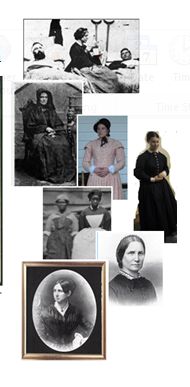Civil War Nurses Series: Interesting Facts about Northern Nurses
One great misconception many people have regarding nurses in both the Union and Confederacy is that they assisted the surgeons in medical procedures. This was for the most part not the case, except in rare situations in the field. During the Civil War women of both sides confined their duties to fit within the domestic sphere including providing religious counsel, aiding the mortally wounded soldier to face a “good death,” and writing about that death to his family.
Here are some interesting facts about Northern Civil war Nurses/Matrons:
Women hospital workers were classified into job categories, but usually soldiers referred to any hospital worker as a nurse or matron. Formal union hospital worker classifications using the term “matron” referred to the woman who had the responsibility of supervising the ward nurses in a general hospital. Union soldiers referred to regimental women (camp followers) who were hired to nurse, cook and do laundry in the field as “matron.” The term “matron also referred to someone who was a chamber maid.
- Over half of the hospital workers were not formally appointed or paid, but volunteer workers.
- Contrabands (African-American slaves who fled into Union lines) were put to work in Union camp hospitals doing various menial jobs such as cooking and laundry.
- Women of all classes worked as hospital workers (very rich, working women, middle-class, Northern free African-Americans, African-American contrabands).
- Working as a nurse or hospital worker was not considered a reputable job for a woman.
- The Union hospital system and paid women nurses di not exist until late 1861 after the First Battle of Manassas.
- Nursing was not a profession prior to the late 1800’s



Thanks Virginia. I’ve been researching this material for five years but the role of nurses and women in hospitals was unclear to me until your short summary.
Dear Sir or Madam: I am a recent subscriber to “Emerging Civil War.” I have enjoyed the various articles. In your January 2012 is was an article entitled “Death, Dying, and Murder” which contain a link to “Disease: A Tale of Two Regiments (Part 2).” I have been unable to locate Part 1. Kindly inform me as to where Part 1 is located. Thank you for your time and efforts on my behalf. Most Respectfully, Your Obd’t. Srv’t. Peter J. D’Onofrio, Ph. D. President Society of Civil War Surgeons, Inc. 539 Bristol Drive, SW Reynoldsburg, OH 43068-9405 740-927-3088 Fax: 614-750-1246 _www.civilwarsurgeons.org_ (http://www.civilwarsurgeons.org/)
Igitur qui desiderat pacem, praeparet bellum (If you want peace, prepare for war) Publius Flavius Vegetius Renatus
“An unlimited power to tax involves, necessarily, a power to destroy; because there is a limit beyond which no institution and no property can bear taxation.” John Marshal
Welcome, good sir, to our pages. In the bar under the image at the top is a list of places to go within Emerging Civil War. One is “Authors.” If you check there, Mrs. Bensen’s written efforts will all be listed as links. Simply click on the link you wish.
While you are there, perhaps you might peruse my own efforts concerning embalming.
Y’r Ob’dnt Servant.
Miss Meg Thompson
Virginia–so nice to read you again! Huzzah!
Along with the somewhere between 700-1000 women who dressed as men and fought alongside husbands and brothers or just on their own in the Civil War, there were definitely women caring for the men providing much more than nursing (more lock a doctor’s care) in the battlefields. They were not merely serving as domestic matrons in hospitals well away from the battlefronts.
You are right in many respects. In the article I was referring to mostly the “Sanitary Commission nurses” and to the Confederate hospital nurses. There were exceptions especially with the field hospitals where both doctors and the paid nurses were scarce. Aside from the paid nurses of both the Union and Confederate armies, their paid medical staff (doctors and nurses) and many local women provided whatever medical care that they could.
Interesting
2nd bullet from the bottom has a typo it should be did not di